The global lithium and lithium-ion battery electrolyte market is anticipated to grow from USD 5.8 billion in 2025 to USD 18.3 billion by 2035, advancing at a CAGR of 12.2%. The industry stands at the threshold of a decade-long expansion trajectory that promises to reshape energy storage technology and electric vehicle manufacturing solutions. The market's journey from USD 5.8 billion in 2025 to USD 18.3 billion by 2035 represents substantial growth, demonstrating the accelerating adoption of advanced electrolyte formulations and battery production technology across automotive, consumer electronics, energy storage, and industrial manufacturing sectors.
The first half of the decade (2025-2030) will witness the market climbing from USD 5.8 billion to approximately USD 10.3 billion, adding USD 4.5 billion in value, which constitutes 36% of the total forecast growth period. This phase will be characterized by the rapid adoption of liquid lithium-based electrolyte systems, driven by increasing electric vehicle production volumes and the growing need for high-performance energy storage solutions worldwide. Advanced electrochemical properties and automated manufacturing systems will become standard expectations rather than premium options.
The latter half (2030-2035) will witness accelerated growth from USD 10.3 billion to USD 18.3 billion, representing an addition of USD 8.0 billion or 64% of the decade's expansion. This period will be defined by mass market penetration of solid-state and gel electrolyte technologies, integration with next-generation battery platforms, and seamless compatibility with automotive electrification infrastructure. The market trajectory signals fundamental shifts in how battery manufacturers approach electrolyte optimization and energy density management, with participants positioned to benefit from steady demand across multiple product types and application segments.
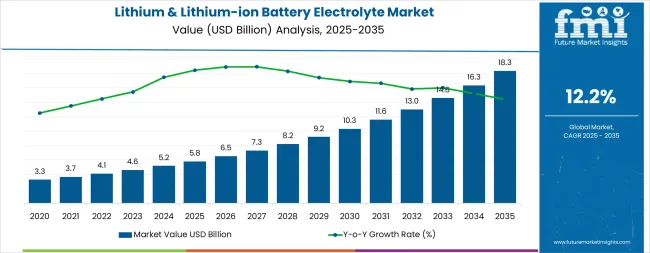
The market demonstrates distinct growth phases with varying market characteristics and competitive dynamics. Between 2025 and 2030, the market progresses through its rapid expansion phase, growing from USD 5.8 billion to USD 10.3 billion with robust annual increments averaging 12.2% growth. This period showcases the transition from conventional electrolyte formulations to advanced lithium-based systems with enhanced ionic conductivity and integrated safety mechanisms becoming mainstream features.
The 2025-2030 phase adds USD 4.5 billion to market value, representing 36% of total decade expansion. Market maturation factors include standardization of battery manufacturing protocols, declining component costs for lithium salts and solvents, and increasing automotive industry awareness of electrolyte benefits reaching optimal performance in electric vehicle and energy storage applications. Competitive landscape evolution during this period features established chemical companies like Mitsubishi Chemical and Shenzhen Capchem expanding their electrolyte portfolios while specialty manufacturers focus on high-voltage formulation development and enhanced electrochemical capabilities.
From 2030 to 2035, market dynamics shift toward solid-state integration and global EV production expansion, with accelerated growth continuing from USD 10.3 billion to USD 18.3 billion, adding USD 8.0 billion or 64% of total expansion. This phase transition centers on next-generation electrolyte systems, integration with solid-state battery networks, and deployment across diverse automotive and energy storage scenarios, becoming standard rather than specialized applications. The competitive environment matures with focus shifting from basic electrolyte capability to comprehensive battery performance optimization systems and integration with battery management platforms.
| Metric | Value |
|---|---|
| Market Value (2025) | USD 5.8 billion |
| Market Forecast (2035) | USD 18.3 billion |
| Growth Rate | 12.2% CAGR |
| Leading Technology | Lithium-based Product Type |
| Primary Application | Automotive End Use Segment |
The market demonstrates strong fundamentals with lithium-based systems capturing a dominant share through advanced electrochemical performance and battery optimization capabilities. Automotive applications drive primary demand, supported by increasing electric vehicle production and energy storage technology requirements. Geographic expansion remains concentrated in developed markets with established automotive infrastructure, while emerging economies show accelerating adoption rates driven by EV manufacturing expansion and rising clean energy standards.
Market expansion rests on three fundamental shifts driving adoption across the automotive and energy storage sectors. Electric vehicle revolution creates compelling operational advantages through lithium-ion battery electrolytes that provide superior ionic conductivity and energy density without performance degradation, enabling automotive manufacturers to meet range requirements while maintaining battery safety and reducing total ownership costs. Energy storage infrastructure development accelerates as grid-scale facilities worldwide seek advanced electrolyte systems that complement renewable energy integration, enabling precise charge-discharge management and cycle life optimization that align with utility standards and energy efficiency regulations.
Battery technology advancement drives adoption from automotive manufacturers and energy storage operators requiring high-performance electrolyte solutions that maximize energy density while maintaining thermal stability during charging and discharging operations. The convergence of government EV mandates, declining battery costs, and consumer demand for electric mobility creates steady market momentum. Growth faces headwinds from raw material price volatility that varies across lithium suppliers regarding the sourcing of lithium salts and organic solvents, which may limit adoption in cost-sensitive manufacturing environments. Technical challenges also persist regarding thermal stability and safety concerns that may reduce effectiveness in extreme temperature conditions, which affect battery performance and operational safety requirements.
The lithium and lithium-ion battery electrolyte market represents a critical energy technology opportunity driven by expanding global electric vehicle adoption, energy storage infrastructure development, and the need for superior electrochemical performance. The market's growth trajectory from USD 5.8 billion in 2025 to USD 18.3 billion by 2035 at a 12.2% CAGR reflects fundamental shifts in battery technology requirements. Geographic expansion opportunities are particularly pronounced in Asia-Pacific markets, where the dominance of lithium-based systems (84.0% market share) and automotive applications (36.0% share) provides clear strategic focus areas.
Strengthening the dominant lithium-based segment (84.0% market share) through enhanced formulation chemistry, superior electrochemical stability, and high-voltage compatibility. This pathway focuses on optimizing lithium salt concentrations, extending operational voltage windows to 4.5V+ systems, and developing specialized formulations for diverse battery applications. Market leadership consolidation through advanced electrochemical engineering and automated dispensing integration enables premium positioning while defending competitive advantages. Expected revenue pool: USD 1.8-2.8 billion
Rapid electric vehicle growth across India (18.1% CAGR) and China (13.6% CAGR) creates substantial opportunities through local production capabilities and technology partnerships. Localization strategies reduce import costs, enable faster technical support, and position companies advantageously for automotive procurement programs while accessing growing domestic markets. Expected revenue pool: USD 1.5-2.3 billion
Expansion within the automotive segment (36.0% market share) through specialized formulations addressing EV quality standards and high-voltage battery requirements. This pathway encompasses fast-charging compatibility, thermal stability enhancement, and compatibility with diverse EV battery architectures, supporting modern electric vehicle battery production. Expected revenue pool: USD 1.2-1.9 billion
Strategic expansion into Power & Energy applications (20.0% market share) requires enhanced cycle life and specialized formulations addressing grid-scale operational requirements. This pathway addresses stationary energy storage, renewable integration, and utility-scale battery systems with advanced electrochemical engineering for demanding conditions while creating opportunities for long-term supply agreements. Expected revenue pool: USD 900 million-1.5 billion
Development of next-generation electrolyte technologies, including solid-state electrolytes (7.0% share) and gel formulations (5.0% share), addressing enhanced safety needs and high-energy-density demands. Technology differentiation through proprietary formulations and solid-state compatibility enables diversified revenue streams while expanding addressable market opportunities in premium automotive segments. Expected revenue pool: USD 800 million-1.3 billion
Expansion within the consumer electronics segment (34.0% market share) through compact battery optimization and high-energy-density formulations. This pathway encompasses fast-charging electrolytes, miniaturized battery systems, and comprehensive safety features for portable applications, creating opportunities for high-volume manufacturing relationships. Expected revenue pool: USD 700 million-1.2 billion
Development of environmentally superior electrolyte formulations addressing regulatory compliance and sustainability requirements. This pathway encompasses reduced-toxicity solvents, ecofriendly lithium salt sourcing, and recyclability-enhanced formulations. Premium positioning reflects environmental leadership while enabling access to environmentally-focused procurement programs and green automotive partnerships. Expected revenue pool: USD 600 million-1.0 billion
Primary Classification: The market segments by product type into Lithium-based, Sulfide-based, Polymer-based, Oxide-based, and Others categories, representing the evolution from conventional liquid electrolytes to advanced solid-state and hybrid solutions for comprehensive battery performance optimization.
Secondary Classification: Form segmentation divides the market into Liquid, Solid, and Gel sectors, reflecting distinct requirements for electrochemical performance, manufacturing compatibility, and battery architecture standards.
Tertiary Classification: End use segmentation covers Automotive, Consumer Electronics, Power & Energy, and General Industrial applications, demonstrating varied adoption patterns across electric vehicles, portable devices, grid storage, and industrial equipment sectors.
Regional Classification: Geographic distribution covers North America, Europe, Asia Pacific, Latin America, and the Middle East & Africa, with developed markets leading adoption while emerging economies show accelerating growth patterns driven by EV manufacturing expansion programs.
The segmentation structure reveals technology progression from standard lithium-based formulations toward next-generation solid-state systems with enhanced safety and performance capabilities, while application diversity spans from electric vehicle batteries to grid-scale energy storage requiring precise electrochemical solutions.
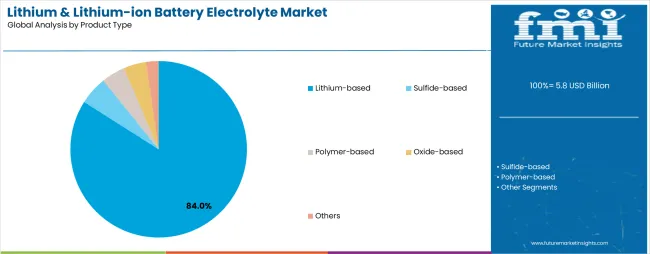
Market Position: Lithium-based electrolyte systems command the leading position in the market with approximately 84.0% market share through advanced electrochemical properties, including superior ionic conductivity, wide electrochemical window capability, and energy density optimization that enable battery manufacturers to achieve optimal performance across diverse automotive and energy storage applications.
Value Drivers: The segment benefits from battery manufacturer preference for proven electrolyte systems that provide consistent electrochemical performance, extended cycle life, and manufacturing scalability without requiring significant process modifications. Advanced formulation features enable high-voltage battery compatibility, thermal stability, and integration with existing cell production equipment, where electrochemical performance and safety represent critical operational requirements.
Competitive Advantages: Lithium-based systems differentiate through established supply chains, mature manufacturing processes, and compatibility with current lithium-ion battery architectures that enhance operational effectiveness while maintaining optimal energy density suitable for diverse automotive and stationary storage applications.
Key market characteristics:
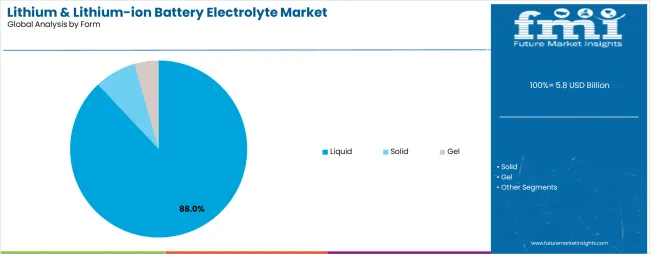
Market Context: Liquid electrolyte forms dominate the market with approximately 88.0% market share due to widespread adoption in current battery manufacturing and established compatibility with lithium-ion cell architectures, production equipment, and quality control systems that enable efficient battery assembly across automotive and consumer electronics applications.
Appeal Factors: Battery manufacturers prioritize liquid electrolytes for manufacturing simplicity, cost-effectiveness, and proven performance in commercial battery systems that enable coordinated production across multiple cell formats. The segment benefits from substantial industry investment and mature supply chains that prioritize liquid electrolyte systems for high-volume production and operational efficiency applications.
Growth Drivers: Electric vehicle production expansion incorporates liquid electrolytes as standard materials for battery cell manufacturing, while consumer electronics growth increases demand for established electrochemical solutions that comply with industry standards and minimize production complexity.
Application dynamics include:
Solid electrolyte forms capture approximately 7.0% market share through next-generation battery applications, enhanced safety characteristics, and compatibility with solid-state battery architectures. Gel electrolytes account for 5.0% share, offering intermediate solutions between liquid and solid forms with improved safety and performance characteristics for specialized battery applications.
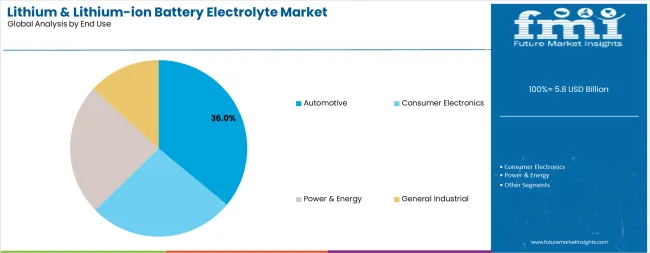
Market Context: Automotive applications dominate the market with approximately 36.0% market share due to rapid electric vehicle adoption and increasing focus on battery performance optimization, energy density management, and safety enhancement applications that support transportation electrification goals.
Appeal Factors: Automotive manufacturers prioritize electrolyte reliability, energy density, and thermal stability for electric vehicle batteries that enable extended driving range and fast-charging capabilities. The segment benefits from substantial government incentives and consumer demand for electric mobility that prioritize acquisition of high-performance electrolyte systems for vehicle battery applications.
Growth Drivers: EV production expansion programs incorporate advanced electrolytes as critical components for battery manufacturing, while automotive industry electrification increases demand for proven electrochemical solutions that comply with safety standards and performance requirements.
Market Challenges: Varying automotive battery architectures and regional safety standards may limit electrolyte standardization across different vehicle platforms or operational scenarios.
Application dynamics include:
Growth Accelerators: Electric vehicle proliferation drives primary adoption as lithium-ion battery electrolytes provide energy density and performance capabilities that enable automotive manufacturers to meet range requirements without excessive battery weight, supporting transportation electrification and climate goals that require high-performance energy storage solutions. Renewable energy integration accelerates market expansion as grid-scale storage facilities seek effective electrolyte systems that maximize cycle life while maintaining operational effectiveness during frequent charge-discharge scenarios. Battery technology investment increases worldwide, creating steady demand for advanced electrolyte formulations that enable next-generation battery architectures and provide operational flexibility in complex energy storage environments.
Growth Inhibitors: Raw material cost volatility varies across lithium suppliers regarding the sourcing of lithium salts, carbonate solvents, and specialty additives, which may limit operational flexibility and market penetration in regions with unstable commodity prices or cost-sensitive battery manufacturing operations. Safety and thermal stability limitations persist regarding flammability concerns and thermal runaway risks that may reduce effectiveness in extreme temperature or abuse conditions, affecting battery safety and operational reliability. Market fragmentation across multiple battery chemistries and cell formats creates compatibility concerns between different electrolyte formulations and existing battery architectures.
Market Evolution Patterns: Adoption accelerates in automotive and energy storage sectors where performance requirements justify electrolyte costs, with geographic concentration in developed markets transitioning toward mainstream adoption in emerging economies driven by EV manufacturing expansion and renewable energy development. Technology development focuses on solid-state electrolyte formulations, improved safety additives, and integration with high-voltage battery systems that optimize energy density and operational safety. The market could face disruption if alternative battery technologies or sodium-ion chemistries significantly reduce reliance on lithium-based electrolyte systems in mainstream energy storage applications. Industry 4.0 integration enables real-time electrolyte performance monitoring, predictive quality management, and automated dispensing systems that optimize manufacturing efficiency while supporting battery producers' transition toward smart manufacturing and comprehensive production optimization platforms.
The Lithium & Lithium-ion Battery Electrolyte market demonstrates varied regional dynamics with Growth Leaders including India (18.1% CAGR) and Germany (18.0% CAGR) driving expansion through aggressive EV programs and battery manufacturing infrastructure development. High-Growth Markets encompass China (13.6% CAGR) and Japan (12.3% CAGR), benefiting from established battery industries and advanced technology development. Steady Performers feature the United States (6.8% CAGR), United Kingdom (4.7% CAGR), and Australia (4.6% CAGR), where automotive electrification and energy storage adoption support consistent growth patterns.
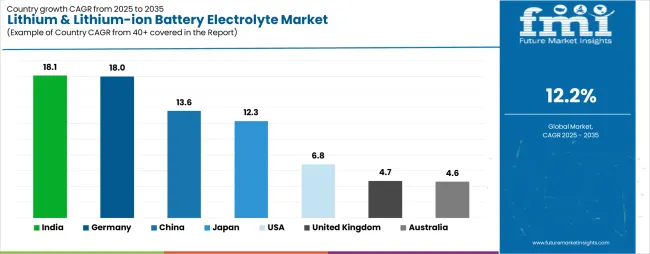
| Country | CAGR (2025-2035) |
|---|---|
| India | 18.1% |
| Germany | 18.0% |
| China | 13.6% |
| Japan | 12.3% |
| United States | 6.8% |
| United Kingdom | 4.7% |
| Australia | 4.6% |
Regional synthesis reveals Asia-Pacific markets leading adoption through EV manufacturing expansion and battery production infrastructure development, while European countries maintain rapid growth supported by automotive electrification policies and battery manufacturing localization requirements. North American markets show moderate growth driven by federal incentives and domestic battery supply chain development.
India establishes the highest growth trajectory through aggressive electric vehicle incentive programs and comprehensive battery manufacturing infrastructure development, integrating advanced lithium-ion battery electrolytes as critical components in automotive battery production and energy storage installations. The country's 18.1% CAGR reflects government initiatives promoting domestic EV adoption and battery manufacturing capabilities that mandate the use of advanced electrolyte systems in vehicle battery and stationary storage facilities. Growth concentrates in major industrial centers, including Mumbai, Chennai, and Delhi, where battery manufacturing development showcases integrated electrolyte supply chains that appeal to domestic battery producers seeking localized material sourcing and cost-competitive production capabilities.
Indian battery manufacturers are developing partnerships with international electrolyte suppliers that combine technology transfer with domestic production advantages, including cost-effective manufacturing and proximity to growing EV markets. Distribution channels through automotive industry suppliers and battery material distributors expand market access, while government support for battery manufacturing localization supports adoption across diverse automotive and energy storage segments.
Strategic Market Indicators:
In Stuttgart, Munich, and Frankfurt, automotive manufacturers and battery production facilities are implementing advanced lithium-ion battery electrolytes as standard materials for electric vehicle battery production and energy storage applications, driven by increasing automotive electrification and manufacturing localization programs that prioritize the importance of secure electrolyte supply chains. The market achieves an 18.0% CAGR, supported by EU battery regulations and automotive industry transformation programs that promote domestic battery manufacturing and electrolyte production facilities. German battery manufacturers are adopting high-purity electrolyte systems that provide superior performance and safety features, particularly appealing in premium automotive segments where battery quality and operational reliability represent critical competitive requirements.
Market expansion benefits from established chemical manufacturing infrastructure and automotive industry expertise that enable rapid adoption of advanced electrolyte technologies for EV battery production. Technology development follows patterns established in automotive chemicals, where quality and performance drive procurement decisions and operational deployment.
Market Intelligence Brief:
China's advanced battery manufacturing ecosystem demonstrates sophisticated lithium-ion battery electrolyte deployment with documented operational effectiveness in EV battery production and energy storage applications through integration with vertically integrated supply chains and production infrastructure. The country leverages manufacturing scale and battery technology expertise to maintain a 13.6% CAGR. Industrial centers, including Shanghai, Guangzhou, and Tianjin, showcase extensive installations where electrolyte systems integrate with comprehensive battery production platforms and quality management systems to optimize cell performance and manufacturing efficiency.
Chinese electrolyte manufacturers prioritize production capacity and cost competitiveness in formulation development, creating demand for scalable electrolyte systems with proven features, including high ionic conductivity and manufacturing compatibility. The market benefits from established battery manufacturing infrastructure and substantial investment in next-generation battery technologies that provide long-term growth opportunities.
Market Intelligence Brief:
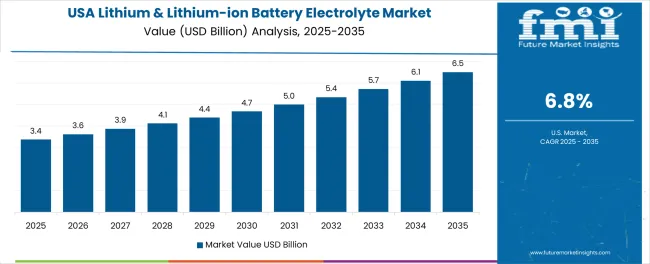
The USA market prioritizes battery manufacturing localization and supply chain security, including electrolyte production facilities and integration with comprehensive automotive platforms that manage battery performance, safety monitoring, and cost optimization applications through unified management systems. The country holds a 6.8% CAGR, driven by federal EV incentives and Inflation Reduction Act provisions that support domestic battery material manufacturing. American battery producers prioritize operational reliability with electrolyte systems delivering consistent electrochemical performance through advanced formulation development and manufacturing quality standards.
Technology deployment channels include major automotive manufacturers, battery producers, and energy storage developers that support professional applications for complex EV battery and grid storage applications. Manufacturing localization capabilities with established automotive partnerships expand market appeal across diverse operational requirements seeking supply chain security and performance benefits.
Performance Metrics:
In Birmingham, Manchester, and other automotive centers, British battery research facilities and automotive manufacturers are implementing advanced electrolyte systems to enhance battery performance capabilities and support electric vehicle production that aligns with UK automotive regulations and clean transport standards. The UK market holds a 4.7% CAGR, driven by innovation programs and battery manufacturing development that prioritize next-generation electrolyte technologies for automotive and energy storage applications. British research institutions are prioritizing solid-state and gel electrolyte development while maintaining focus on manufacturing scalability and automotive safety compliance, particularly important in premium vehicle segments and advanced battery applications.
Market expansion benefits from government research funding and automotive industry partnerships that support electrolyte innovation and commercial deployment across the UK's emerging battery manufacturing and automotive sectors, where technological advancement and safety represent critical requirements.
Strategic Market Indicators:
Japan demonstrates steady market development with a 12.3% CAGR, distinguished by battery manufacturers' preference for high-purity electrolyte systems that integrate seamlessly with advanced battery architectures and provide reliable long-term performance in automotive and consumer electronics applications. The market prioritizes next-generation features, including solid-state electrolyte research, polymer electrolyte development, and integration with high-voltage battery systems that reflect Japanese battery industry expectations for technological sophistication and operational excellence.
In Sydney, Melbourne, and emerging battery manufacturing hubs, Australian research facilities and mining companies are developing advanced electrolyte systems that capitalize on the nation's abundant lithium resources to support domestic battery production and energy storage infrastructure aligned with Australia's renewable energy targets and grid modernization initiatives. The Australian market holds a 4.6% CAGR, driven by vertical integration strategies and upstream advantages in lithium salt production that prioritize cost-effective electrolyte manufacturing for both automotive and stationary energy storage applications. Australian research organizations are prioritizing lithium-based electrolyte optimization and scalable production methods while maintaining focus on supply chain resilience and export competitiveness, particularly important in large-scale battery energy storage systems and mining electrification applications.
Market expansion benefits from government mineral processing incentives and strategic partnerships between lithium producers and battery manufacturers that support electrolyte production capabilities and commercial deployment across Australia's growing battery manufacturing ecosystem and renewable energy sectors, where resource security and technological self-sufficiency represent critical requirements.
Strategic Market Indicators:

The European Lithium & Lithium-ion Battery Electrolyte market is projected to demonstrate robust growth driven by automotive electrification and battery manufacturing localization initiatives across the continent. Germany is expected to maintain its leadership position with approximately 28% of Europe's market share, supported by its advanced automotive industry and major battery gigafactory developments in Bavaria, Saxony, and North-Rhine Westphalia, where established chemical manufacturers and automotive OEMs collaborate on electrolyte supply chain security.
France follows with approximately 15% share, driven by state-backed battery manufacturing projects and grid-scale energy storage development. The United Kingdom holds approximately 14% share through specialized research programs focusing on solid-state and gel electrolyte innovations for premium automotive applications. Italy commands approximately 12% share, while Spain accounts for approximately 9% through automotive supply chain integration and renewable energy storage projects. The Nordic region represents approximately 8% share, focusing low-carbon manufacturing and renewable-paired storage applications. Benelux contributes approximately 6% through chemical production infrastructure and logistics advantages, with Rest of Europe accounting for approximately 8% driven by Central and Eastern European battery assembly growth and manufacturing expansion programs. Liquid lithium-based electrolytes dominate current demand, with solid-state pilot programs accelerating in Germany, France, and the UK for commercial deployment in the latter forecast period.
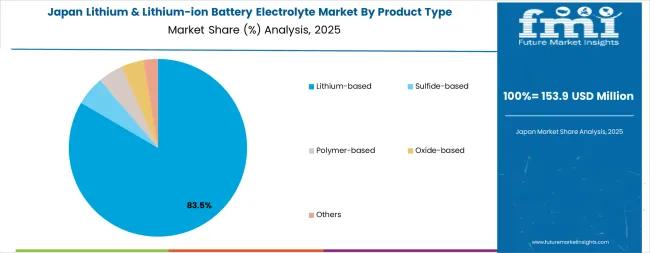
In Japan, the market prioritizes lithium-based formulations, which capture the dominant share of battery manufacturing installations due to their advanced features, including superior ionic conductivity optimization and proven compatibility with existing lithium-ion battery production infrastructure. Japanese battery manufacturers prioritize quality, performance consistency, and long-term reliability, creating demand for lithium-based electrolyte systems that provide stable electrochemical properties and adaptive performance based on battery chemistry requirements and operating conditions. Next-generation solid-state and polymer electrolyte types maintain secondary positions primarily in research applications and specialized battery development programs where advanced safety functionality meets operational requirements without compromising energy density.
Market Characteristics:
In South Korea, the market structure favors international chemical companies, including Mitsubishi Chemical, LG Chem, and specialized electrolyte producers, which maintain dominant positions through comprehensive product portfolios and established battery industry networks supporting both automotive and consumer electronics battery manufacturing installations. These providers offer integrated solutions combining advanced electrolyte formulations with technical support services and quality assurance programs that appeal to Korean battery manufacturers seeking reliable electrochemical systems. Local chemical contractors and material suppliers capture moderate market share by providing localized service capabilities and competitive pricing for standard battery manufacturing applications, while domestic producers focus on specialized formulations and cost-effective solutions tailored to Korean battery industry characteristics.
Channel Insights:
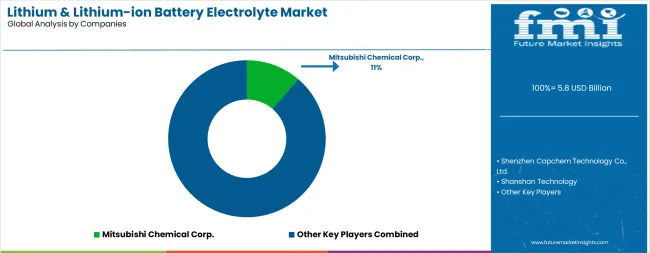
The market operates with moderate concentration, featuring approximately 15-20 meaningful participants, where leading companies control roughly 45-50% of the global market share through established battery industry relationships and comprehensive chemical portfolios. Mitsubishi Chemical Corp. holds the leading position with approximately 11.5% market share through extensive electrochemical expertise, global battery manufacturer partnerships, and advanced formulation capabilities. Competition prioritizes product quality, electrochemical performance, and supply chain reliability rather than price-based rivalry.
Market Leaders encompass Mitsubishi Chemical, Shenzhen Capchem Technology, and Shanshan Technology, which maintain competitive advantages through extensive battery chemistry expertise, global automotive industry networks, and comprehensive quality management capabilities that create customer relationships and support premium positioning. These companies leverage decades of chemical technology experience and ongoing research investments to develop advanced electrolyte formulations with high ionic conductivity and enhanced safety features.
Technology Innovators include Soulbrain MI, Guangzhou Tinci Materials Technology, and UBE Industries, which compete through specialized formulation technology focus and innovative high-voltage electrolyte development that appeal to battery manufacturers seeking advanced performance capabilities and next-generation battery compatibility. These companies differentiate through rapid product development cycles and specialized automotive battery focus.
Regional Specialists feature companies like Zhangjiagang Guotai-Huarong, Panax Etec, and TOMIYAMA Pure Chemical, which focus on specific geographic markets and specialized applications, including high-purity electrolytes and solid-state development programs. Market dynamics favor participants that combine proven electrochemical formulations with reliable supply chains, including consistent quality standards and technical support capabilities. Competitive pressure intensifies as established chemical companies expand into battery materials while specialized electrolyte producers challenge incumbents through innovative formulation solutions and cost-effective manufacturing targeting high-growth EV battery segments.
| Item | Value |
|---|---|
| Quantitative Units | USD 5.8 billion |
| Product Type | Lithium-based, Sulfide-based, Polymer-based, Oxide-based, Others |
| Form | Liquid, Solid, Gel |
| End Use | Automotive, Consumer Electronics, Power & Energy, General Industrial |
| Regions Covered | North America, Europe, Asia Pacific, Latin America, Middle East & Africa |
| Countries Covered | China, India, Germany, Japan, the USA, the UK, Australia, South Korea, and 25+ additional countries |
| Key Companies Profiled | Mitsubishi Chemical Corp., Shenzhen Capchem Technology, Shanshan Technology, Soulbrain MI, Guangzhou Tinci Materials Technology, UBE Industries, Zhangjiagang Guotai-Huarong |
| Additional Attributes | Dollar sales by product type, form, and end use categories, regional adoption trends across North America, Europe, and Asia-Pacific, competitive landscape with chemical manufacturers and battery material suppliers, battery manufacturer preferences for ionic conductivity and electrochemical stability, integration with battery production platforms and quality management systems, innovations in solid-state electrolytes and high-voltage formulations, and development of green manufacturing solutions with enhanced safety and performance optimization capabilities. |
The global lithium & lithium-ion battery electrolyte market is estimated to be valued at USD 5.8 billion in 2025.
The market size for the lithium & lithium-ion battery electrolyte market is projected to reach USD 18.3 billion by 2035.
The lithium & lithium-ion battery electrolyte market is expected to grow at a 12.2% CAGR between 2025 and 2035.
The key product types in lithium & lithium-ion battery electrolyte market are lithium-based, sulfide-based, polymer-based, oxide-based and others.
In terms of form, liquid segment to command 88.0% share in the lithium & lithium-ion battery electrolyte market in 2025.






Our Research Products

The "Full Research Suite" delivers actionable market intel, deep dives on markets or technologies, so clients act faster, cut risk, and unlock growth.

The Leaderboard benchmarks and ranks top vendors, classifying them as Established Leaders, Leading Challengers, or Disruptors & Challengers.

Locates where complements amplify value and substitutes erode it, forecasting net impact by horizon

We deliver granular, decision-grade intel: market sizing, 5-year forecasts, pricing, adoption, usage, revenue, and operational KPIs—plus competitor tracking, regulation, and value chains—across 60 countries broadly.

Spot the shifts before they hit your P&L. We track inflection points, adoption curves, pricing moves, and ecosystem plays to show where demand is heading, why it is changing, and what to do next across high-growth markets and disruptive tech

Real-time reads of user behavior. We track shifting priorities, perceptions of today’s and next-gen services, and provider experience, then pace how fast tech moves from trial to adoption, blending buyer, consumer, and channel inputs with social signals (#WhySwitch, #UX).

Partner with our analyst team to build a custom report designed around your business priorities. From analysing market trends to assessing competitors or crafting bespoke datasets, we tailor insights to your needs.
Supplier Intelligence
Discovery & Profiling
Capacity & Footprint
Performance & Risk
Compliance & Governance
Commercial Readiness
Who Supplies Whom
Scorecards & Shortlists
Playbooks & Docs
Category Intelligence
Definition & Scope
Demand & Use Cases
Cost Drivers
Market Structure
Supply Chain Map
Trade & Policy
Operating Norms
Deliverables
Buyer Intelligence
Account Basics
Spend & Scope
Procurement Model
Vendor Requirements
Terms & Policies
Entry Strategy
Pain Points & Triggers
Outputs
Pricing Analysis
Benchmarks
Trends
Should-Cost
Indexation
Landed Cost
Commercial Terms
Deliverables
Brand Analysis
Positioning & Value Prop
Share & Presence
Customer Evidence
Go-to-Market
Digital & Reputation
Compliance & Trust
KPIs & Gaps
Outputs
Full Research Suite comprises of:
Market outlook & trends analysis
Interviews & case studies
Strategic recommendations
Vendor profiles & capabilities analysis
5-year forecasts
8 regions and 60+ country-level data splits
Market segment data splits
12 months of continuous data updates
DELIVERED AS:
PDF EXCEL ONLINE
Lithium and Lithium Ion Battery Electrolyte Market Analysis - Size, Share, and Forecast Outlook 2025 to 2035
Demand for Lithium & Lithium-ion Battery Electrolyte in EU Size and Share Forecast Outlook 2025 to 2035
Lithium Battery Thermal Runaway Sensor Modules Market Size and Share Forecast Outlook 2025 to 2035
Lithium Battery Shear Wrenches Market Size and Share Forecast Outlook 2025 to 2035
Battery Electrolytes Market Analysis & Forecast by Type, End-Use, and Region through 2035
Lithium-Ion Battery Market Size and Share Forecast Outlook 2025 to 2035
Lithium Ion Battery Separator Market Growth & Trends 2025 to 2035
Lithium Ion Battery Dispersant Market Growth – Trends & Forecast 2024-2034
Lithium Ion Battery Material Market Growth – Trends & Forecast 2024-2034
Lithium Silicon Battery Market Size and Share Forecast Outlook 2025 to 2035
Lithium ion Stationary Battery Storage Market Size and Share Forecast Outlook 2025 to 2035
Lithium Iron Phosphate (LIP) Battery Market Size and Share Forecast Outlook 2025 to 2035
Stationary Lithium-Ion Battery Storage Market Size and Share Forecast Outlook 2025 to 2035
Silicon Anode Lithium Ion Battery Market Size and Share Forecast Outlook 2025 to 2035
Automotive Portable Lithium Iron Phosphate Battery Market Size and Share Forecast Outlook 2025 to 2035
Preheating Tunnel Furnace for Lithium Battery Market Size and Share Forecast Outlook 2025 to 2035
Lithium Compound Market Forecast Outlook 2025 to 2035
Battery Operated Light Market Forecast and Outlook 2025 to 2035
Lithium Mining Market Size and Share Forecast Outlook 2025 to 2035
Battery Voltage Recorder Market Size and Share Forecast Outlook 2025 to 2035

Thank you!
You will receive an email from our Business Development Manager. Please be sure to check your SPAM/JUNK folder too.
Chat With
MaRIA